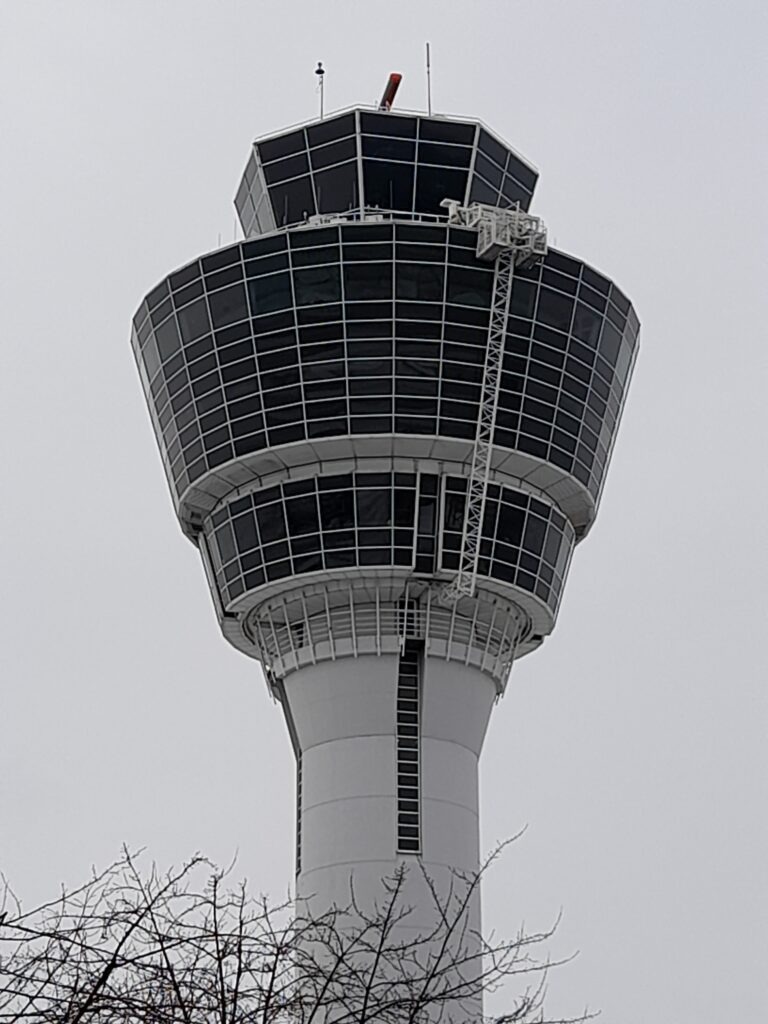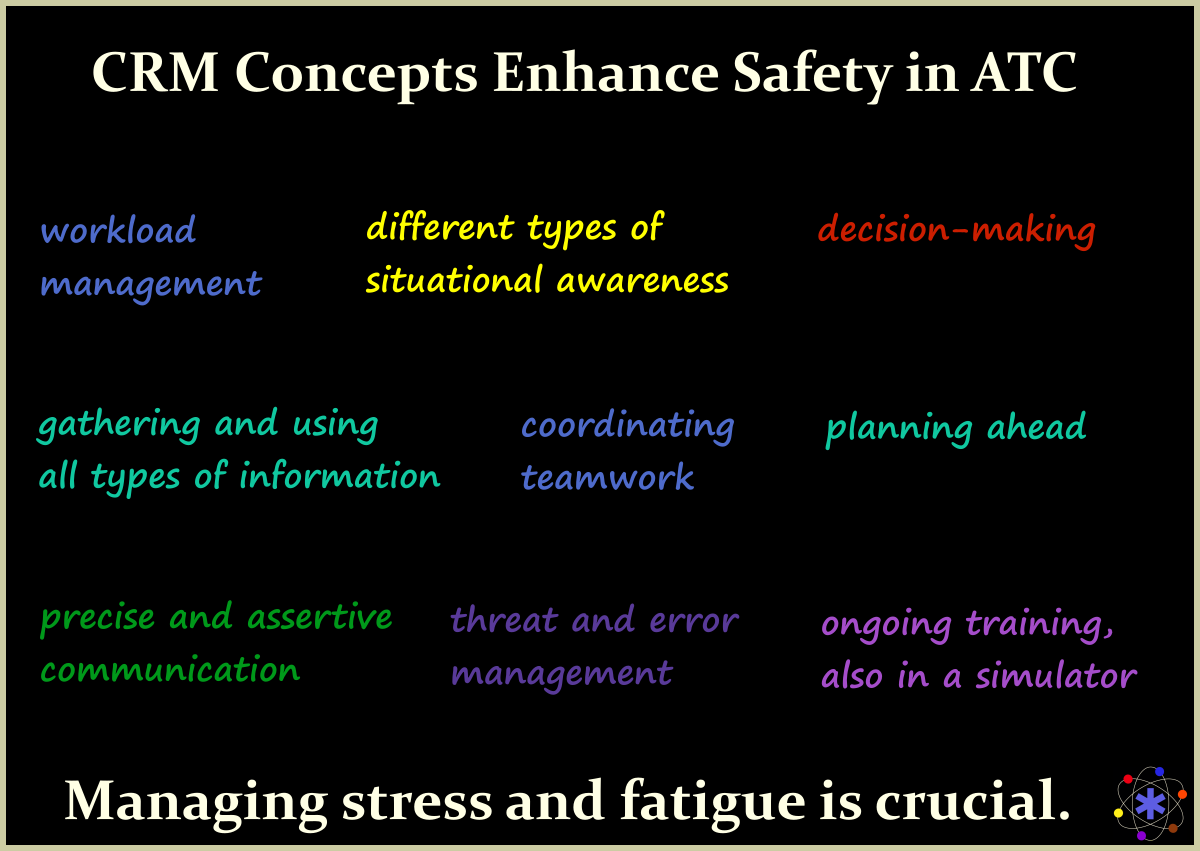Here, you can read what characterises ATC, what services ATC provides, and how CRM is used:
1. We Will Look at a Specific Part of ATC
Air traffic control, ATC, guides all aeroplanes in all phases of their flights, from taxiing out to the runway to taxiing to their final parking position at their destination airport. In doing so, ATC ensures that air traffic flows smoothly. One crucial task is to separate the planes from one another sufficiently in order to prevent collisions. Furthermore, ATC provides information of various types to pilots and helps them in case of an incident.
In this article, we will occupy ourselves with ATC at major civilian airports and the ATC centres which guide airliners carrying passengers and cargo along defined areas of airspace.
As we go along, we will pay particular attention to what CRM concepts can be used in order to enhance the safety in this demanding field of expertise. In the next article, we will highlight the air traffic controller´s profession with a special focus on the human factors.

1.1. When Looking at ATC, We Need to Understand a Few Terms
We will use these terms throughout both articles:
- an airport with its tower, gates, apron (where aircraft are parked, loaded, fuelled and maintained), taxiways, standardised signage, runways
- aerodrome control service (ATC at the airport, includes all vehicles on the ground)
- approach control service (the type of ATC which links the aerodrome control service and area control services, guides aircaft during climb, descend, and approach)
- air space and classes of air space (the classes are named A to G, A to E are serviced, which is not relevant to the content of this article)
- area control services (the type of ATC that covers a certain part of the airspace in which planes cruise)
- ATC clearances (issued at take-off and during all phases of a flight; they allow the pilots, f. ex., to move to a certain flight level)
- separating aircraft appropriately from one another (flight levels and headings, absolutely vital as this prevents collisions)
- flight levels (the altitude in feet at which a plane flies, divided by 100: FL 260 means 26 000 feet, about 8600 metres at standard air pressure)
1.2. Immense Density Characterises Air Traffic Today
At Dallas Fort Worth International Airport, the third bussiest in the world in 2022, a total of 656,676 movments were recorded. On its website, the airport provides statistics showing the operations (take-offs and landings) by months and years. In November 2022, there were 49,076 operations concerning airlines.
Not only at large international airports, but also in the areas along the route, air traffic is extremely dense, and the planes move fast. Hence, it is vital that air traffic controllers pay close attention to their radar screens, as well as to all communication and information. Losing a single plane out of sight for a moment could lead to a major catastrophe.
In the next subchapter, we will look at vital CRM concepts which help the air traffic controllers to deal with the impressive amount of air traffic safely.
2. Important CRM Concepts and ATC
In the following graphic, there is a summary of CRM concepts which are crucial in ATC. We will refer back them when we address communication, ATC at the airport and along a plane´s route. We will cover threat and error management, as well as ongoing training in the second article.

As always in CRM, the various concepts used in ATC are interrelated with one another. Hence, they form a tightly-knit network which improves safety.
3. Optimal Communication Is Vital in ATC
As any type of imprecision and misunderstandings may result in a serious air accident, flawless communication is expected in ATC. We will first address with whom air traffic controllers communicate and what type of information they convey before looking into communication techniques. We will also highlight the role of excellent spoken English.
3.1. With Whom Does ATC Communicate?
- ATC communicates with the pilots via radio
- the aerodrome control service uses radio to communicate with all vehicles on the ground, for instance, passenger busses, tanker lorries, and pushback tractors
- in the tower, the aerodrome control service and the approach control service have to communicate in order to coordinate incoming and outgoing air traffic with the movements of vehicles on the ground
- air traffic controllers contact additional services and agencies in order to help pilots in case of an incident or emergency; in this case, they may also address nearby aircraft to ask about any observations and assistance
3.2. What Does ATC Communicate?
Air traffic controllers gather and process various types of information. They have to decide, which pieces of it are relevant when in their work. Some of the information is essential for the pilots and, thus, communicated to them. Today, ATC gains a large part of information, including flight plans and weather forecasts, from automated systems.
This list shows some examples of communication content:
- at the airport: f. ex. take-off clearance (pilots cannot commence their take-off roll without it), clearance to taxi off the runway after landing
- approach control service: route clearance, which provides the first directions after take-off, such as turns; instructions to contact the first area control service
- area control service: standardised first and last contact as an airliner enters or leaves the respective section, flight levels and headings
- so-called notices to airmen, NOTAMS, which contain potential hazards that may influence the safety of a flight
- further information such as adverse weather conditions and any wind shear prior to the landing
3.3. ATC Uses Professional Communication Techniques
In ATC, all messages must be clear and easily comprehensible in order to prevent misunderstandings. Standard phraseology and closed communication loops help to ensure that every message is understood and the right course of action follows. It goes without saying that discipline and concentration are essential.
In addition, air traffic controllers are expected to communicate with assertiveness as they give instructions which must be followed. Furthermore, they are there to help pilots in precarious situations, which also requires a certain amount of firmness.
3.4. Excellent Knowledge of English and Aeronautical English in Particular Is Required in ATC
Although the native language may be used at regional airports, English has to be spoken on request there, as well. Generally speaking, the International Civil Aviation Organisation, ICAO, requires all air traffic controllers to be proficient in English, especially in Aviation English, which is the default language in aviaton. The aim is to eliminate misunderstandings as far as possible.
4. Directing Aeroplanes in and Around an Airport
4.1. Distribution of a Large Workload and Coordination of Teamwork
As we have seen in subchapter one, aerodrome control service and approach control service are provided. At larger airports, several teams of air traffic controllers fulfil different duties, such as coordinating planes and vehicles on the apron and directing all types of traffic on the ground in addition to the aforementioned services.
From a CRM point of view, we can see that a larger workload at huge airports is shared between more teams. Each of those concentrates on one certain part of the tasks. In addition, the respective teams have to coordinate their work for the best possible flow of all traffic, even if delays or incidents occur. For instance, a slot between two landings has to be used to allow a vehicle to cross the respective runway.
4.2. Aerodrome Control Service
Situational Awareness and the Coordination of Planes and Vehicles
Air traffic controllers who direct the airliners within the airport need excellent spatial awareness, as all air traffic controllers do. They have to visualise for themselves where the planes are at any given moment. They have to take into account in what direction the planes and all types of vehicles move. The surface movement radar, SMR, is used especially in adverse weather conditions.
The awareness of time helps the air traffic controllers to determine what plane or vehicle needs their attention at what point in time. Furthermore, ATC employees must be aware of all information and all their resources as they plan the next steps of their work.
4.3. Approach Control Service
In this particular part of ATC services, the air traffic controllers are in contact with the pilots who are about to take off or land their aeroplanes. As in any phase of a flight, the separation of aircraft must be ensured. One important reason for this is the following phenomenon.
When a plane takes off, vortices start to form at the wingtips and lead to the so-called wake turbulence, a strong type of tubulence which occurs behind the plane. It would be devastating for the following plane to fly into that wake turbulence.
Delays and other disruptions of schedules, especially at highly frequented airports, require firm decision-making skills. For instance, air traffic controllers must decide quickly if they need to instruct a plane to stay in a holding pattern before they can clear it to land.
5. Aeroplanes Need Guidance en Route to Their Destination
As we have already said, airliners are monitored in every phase of their flights. Hence, they enter and leave all the clearly defined sections of airspace, the so-called flight information regions, FIR, along their routes. Whilst they are in one of these FIRs, the air traffic controllers in the area control service follow them on their radar screens and guide them.
5.1. Where Is This Type of ATC Located?
So-called ATC centres oversee all air traffic within a flight information region, FIR. In larger countries, such an FIR is divided into several regional flight information regions. In these ATC centres, the air traffic controllers carry out their work in large and often windowless rooms full of computer and other screens and telephones. Hence, they cannot see the planes directly as ATC personnel in an airport tower does.
5.2. The Spatial Situational Awareness Must Be Three Dimensional
On their radar screens, the air traffic controllers see the planes as moving dots which have tags that provide additional information, such as the identification, speed, heading, and the flight level. As separating the planes when they are cruising is still a major task in order to avoid a collision, the air traffic controllers have to envision the planes moving in a three dimensional space. Are there any planes on the same flight level? At what speed do two of them fly towards one another?
5.3. All ATC Employees Have to Manage Their Respective Workload
As we have seen, air traffic controllers have to gather and process highly relevant information, monitor the aircraft on their screens, and communicate vital instructions, messages and advice to the pilots. The density of air traffic, as well as unforeseen delays, or incidents add to the workload, which ATC employees have to manage.
6. What Can We Transfer From ATC to Our Work?
Most of us won´t be responsible for the safety of hundreds of passengers during every single minute at work. Nevertheless, we can use the insights to reflect on the factors which add compexity to our respective professions and might provoke errors.
In order to disentangle this complexity and, thus, minimise our risk for errors, we might want to answer these example questions:
- How large is our workload? How can we distribute it advantageously?
- What type of situational awareness do we need when?
- Where do we need to process various types of information in a short amount of time?
- What decisions do we have to make swiftly and what consequences might they entail?
When you are new to CRM, but have found your first answers to the questions above nonetheless, you have taken relevant primary steps. Those of you, who are already familiar to CRM, keep integrating and maintaining CRM in your daily work routine.
Last but not least, we should all remember to relax and counteract stress and fatigue.
If you have read the entire article and contemplated all its topics in-depth, you have done excellent work!
7. In the Next Article, the Air Traffic Controllers Take Centre Stage
In the next blog article, we will deal with intriguing questions: What does it take to make a career in this highly demanding, but rewarding profession? What role do the human factors play and how can CRM help? Last, but not least, what do air traffic controllers think of the automation at their workplaces? Be prepared to gain some fascinating insights.
Author: Eva-Maria Schottdorf
Date: January 29th, 2024
On my blog page , I have linked more blog articles for you.
After one year, the articles will be removed from the blog page, updated, augmented and turned into books. You can purchase these directly on the page "A Special CRM Book Series" . The first volume is already waiting there for you.
